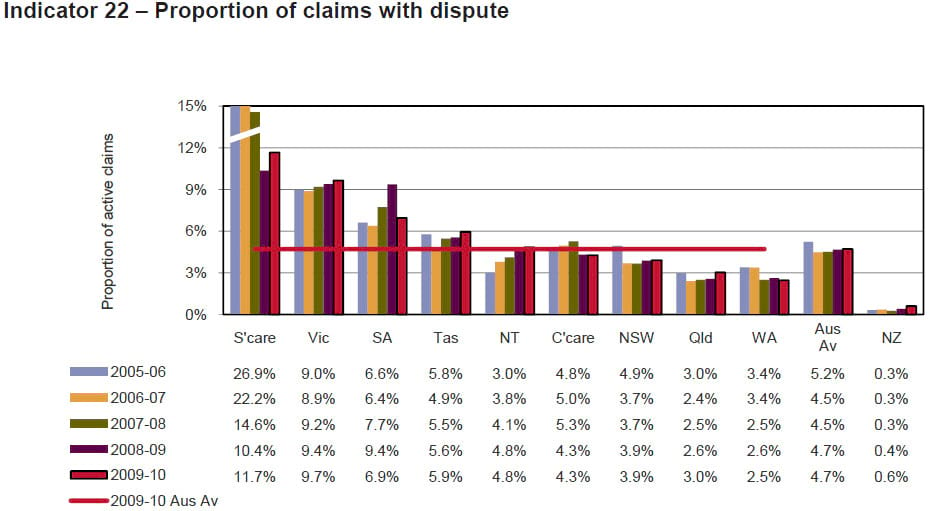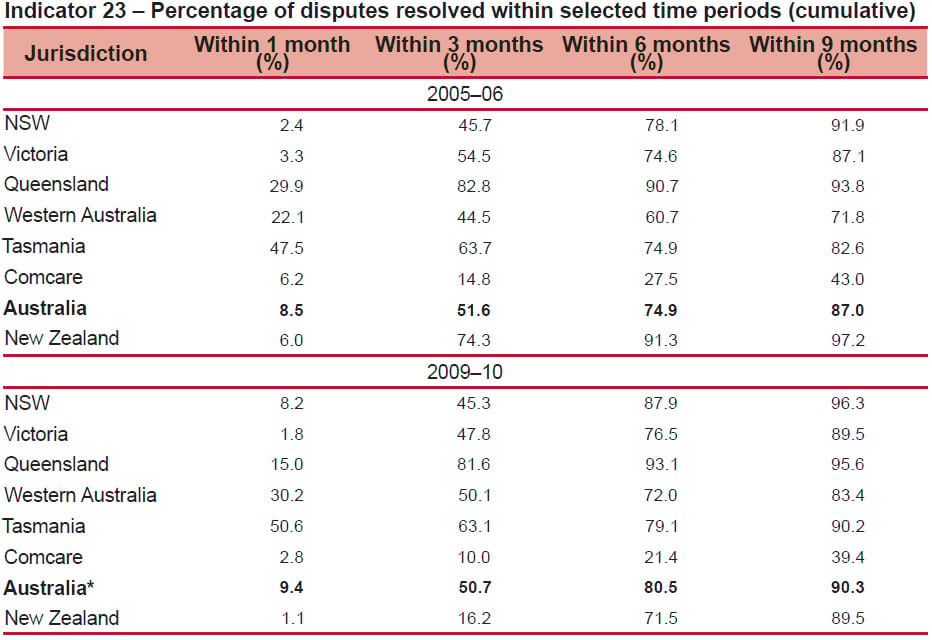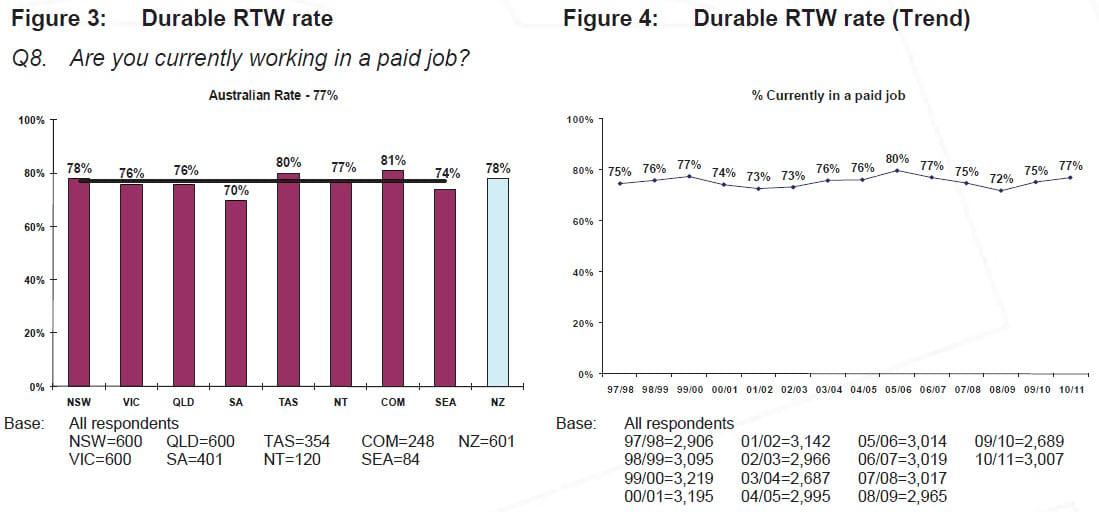Consider the alternative: Part 5 - Queensland

In Part 5 of our series on the use of ADR in workers’ compensation disputes we chat to Elizabeth Woods, CEO of Q-COMP. Previous articles in this series include:
- Part 1 – An Introduction to Alternative Dispute Resolution
- Part 2 – What makes a good ADR system with Nerida Wallace, Principal of Transformation Management
- Part 3 – Victoria
- Part 4 – New South Wales with Sian Leathem, Registrar of the NSW Workers Compensation Commission
WORKERS’ COMPENSATION IN QUEENSLAND BY THE NUMBERS
By the numbers, Queensland has the second lowest level of initials disputes, and the second highest level of resolutions.
According to Ms Woods, “right at the beginning, it’s quite different from other schemes.”
Disputation Rates

Table from the 2011 Comparative Performance Monitoring Report (p. 39)
After a slight increase in 2009-10, Queensland now has the second lowest disputation rate in the country. The 2009-10 rate of 3.0% remains comfortably below the national average of 4.7%.
Resolution Rates

Table from the 2011 Comparative Performance Monitoring Report (p. 39)
In 2009-10 Queensland resolved the highest proportion of disputes (82%) within 3 months from the date of lodgement. Although the Comparative Performance Monitoring Report warns us to treat all numbers with ‘caution’ owing to the differences in scheme design (ie what decisions can be appealed, dispute resolution models, complexity of disputes being dealt with), the combination of a unique approach and these numbers make Queensland a compelling case study.
Durable Return To Work

Table from the Heads of Workers' Compensation Authorities RTW Monitor 2010/11 (p. 2)
At 76%, Queensland's durable RTW rate for 2010-11 sits 1% below the national average of 77%.
WHAT’S WORKING WELL
Ms Woods suggests that in both medical and legal dispute resolutions, the system is functioning well.
Medical Dispute Resolution
In terms of medical disputes (ie whether the worker has an ‘ongoing incapacity’ or ‘permanent impairment’), the system provides for the kind of efficiency and finality that Nerida Wallace spoke of as important in Part 2 of this series.
If a worker is unhappy with the decision of the insurer (in Queensland, all workers' compensation insurance is managed by WorkCover Queensland) regarding their injury, they can take their complaint to a Medical Assessment Tribunal (MAT). The MAT is comprised of 3 independent specialists (or “disinterested parties”) whose assessment is final.
Further, assessments are generally made quickly. “Within the MAT process there are very short timeframes” Ms Wood says, adding that Q-COMP’s KPI aims to have people in the Tribunal within 6 weeks (“you can’t even get a specialist appointment in 6 weeks, but we can get 3 specialists there for you”).
Legal Dispute Resolution
In the situation where an employee is unhappy with an insurer rejecting their claim (or an employer is unhappy with an insurer accepting a claim), a review of that decision by Q-COMP can be sought. Parties who are unhappy with Q-COMP’s review can appeal the findings.
Ms Woods breaks down the rough numbers like this:
- 100,000 make claims with the insurer;
- 3,500 object to the insurer’s findings and seek review with Q-COMP; and
- 350 object to the Q-COMP review.
“I think that the system works very well because, in my view, the numbers speak for themselves.”
As with the medical disputes, tightly controlled timelines are key to efficient outcomes. Q-COMP's timeline is as follows:
- the insurer has 20 days to make the initial decision;
- parties then have 3 months to request a review of that decision by Q-COMP;
- Q-COMP then has 25 business days to make a decision (and inform the party within 10 days of that decision); and finally
- the injured party then has 10 business days to seek leave to appeal Q-COMP’s decision with the Queensland Industrial Relations Commission.
“For all bar 350 people a year, it’s a very short process, so that is what I would say works really well, because one of the things I think that is inherently wrong with other systems is that they don’t give people finality”, Ms Woods said.
DEALING WITH THE CRITCISM OF ‘COST-SHIFTING’
Ms Woods addressed criticism of the QLD system that suggests its speedy resolution of workers’ compensation claims merely shifts the problem. “One criticism of the short-tail scheme is that all it is really doing is ‘cost shifting’ the exercise of getting people back into the workforce, onto another system (ie Centrelink)”.
Ms Woods responds by saying that now under legislation “at the end of the insurer claim if a person is without a job there is a mandatory referral to Q-COMP, and I have set up a program called ‘Return To Work Assist’, what that involves is helping those people get a job”.
This integration of a return to work program into a workers’ compensation scheme is one of Q-COMP's approaches to deal with return to work. "We don’t talk about your injury, we ask ‘what would you like to do now?’". "We’ve got a 70% return to work rate at the moment, it’s truly amazing” Ms Woods said, “so that’s the good news in terms of what our scheme is doing differently.”
New legislation means that an injure worker's refusal to participate in the Return To Work Assist program can be used as evidence that they have not mitigated the effects of their injury (for the purposes of a Common Law claim). Ms Woods doesn't hide the fact that system "will well and truly conspire" to get the person into rehab.
THE BOTTOM LINE
Of the system Ms Wood says “it’s fair, it’s easy to use, it’s transparent and it’s timely.” In combination with the return to work efforts of Return To Work Assist, which aims to keep the worker in the system for as little time as possible, she believes it gets them “out the other end, moving on with their life and getting back to work.”

